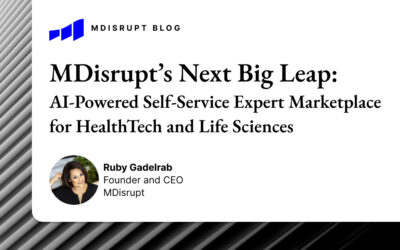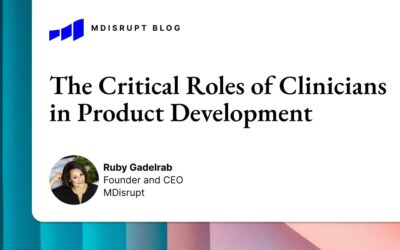
MDisrupt CEO and founder Ruby Gadelrab on why the combination of the two companies is so promising.
Integrating genetics into primary care—for real
On Friday, 23andMe announced its acquisition of Lemonaid Health, the telehealth upstart and drug-delivery service, “in a bid to make its personalized genetics approach part of patients’ primary care,” stated Fortune.
Between 2014 and 2017, I worked at 23andMe as VP of commercial marketing. It was there that I learned the principles of consumerized healthcare. Everyone in the company had a maniacal focus on the consumer experience. Every decision we made as an executive team was through the lens of “How does this positively impact the consumer experience?”
The acquisition of Lemonaid Health is a bold move by 23andMe. I believe that it is rooted in adding value to the consumer experience and has the potential to change the way we approach primary care.
What makes the 23andMe and Lemonaid acquisition so interesting?
Mastering consumer engagement
23andMe has mastered consumer engagement. It was one of the first companies to make genetic information simple and accessible to consumers and to demonstrate that individuals were willing to pay for information on both health and ancestry, with over 11 million consumers buying the tests. 23andMe was the first company to get FDA authorization to sell genetic tests directly to consumers without clinicians being involved in the process. And the company did a fantastic job of communicating the information in reports in a simple and engaging way. Furthermore, they engaged consumers in research, with an over 85% consent rate.
Clinicians are a core part of consumer healthcare
During my time at 23andMe, as consumers became more interested in the health reports that 23andMe provided, they started to take them to their healthcare providers to discuss. The problem was, most healthcare providers had no idea what the report was or what its clinical utility might be. Further, healthcare providers had no time to try and make sense of it in a 20-minute visit. This broke the consumer experience and made it difficult for the valuable information in the 23andMe report to be actionable within our current healthcare system. One of my roles was to create a “23andMe for Medical Professionals” program in an effort to educate clinical early adopters on what the reports meant.
Consumers taking their reports to their healthcare providers created frustration everywhere. Consumers were frustrated that valuable genomic data in their 23andMe report was not taken seriously by their healthcare providers. Healthcare providers were frustrated that they were receiving data outside the standard of care that they did not know how to use or have the right infrastructure to integrate into their patients’ care. The company was frustrated because the healthcare providers’ reactions and underutilization of the 23andMe report ruined their consumers’ experience.
This issue underscores the importance of involving healthcare providers early and often as digital health innovations are built and deployed—something that’s an essential pillar of our work at MDisrupt.
Timing is everything
Genetic information is useful both clinically and personally, and yet traditional healthcare is about ten years behind medical genomics research. This can be attributed to the perceived lack of clinical utility for many genetic tests on the market as well as the “two-year problem.” This is a problem of economics and the ROI of genetic testing. Whoever pays for preventive genetic testing doesn’t get the benefit of it, because people change employers and providers at least every two years.
Post-COVID-19 pandemic, health systems have even less incentive to take an interest in genomics. These days, they have bigger problems: making up the revenue they lost during the pandemic and taking care of the patients whose medical treatment got delayed in the pandemic.
23andMe has the right idea. The only way to create an incredible consumer experience, and to make genomics part of the decision-making process in healthcare, is to own the pipes that can deliver true healthcare—meaning bringing healthcare providers into the process.
This does two things. First, it gives consumers a place to go to discuss their healthcare, genomic data included. Second, it allows a genetic testing company to deliver additional health services to its consumers (i.e., their own telemedicine channel). Having clinicians as part of the genomics journey is the only way to improve the consumer/patient experience, and make genomics meaningful in healthcare.
Genomics + telemedicine + therapeutics = a new category of genomically powered healthcare
Interestingly, it is the combined efforts of two digital health companies and not a genomics company and a healthcare system that may be able to truly integrate genomics into healthcare.
And with 23andMe, it doesn’t stop there. Remember that the company has made significant efforts and investments into therapeutics with a $300M investment and partnership with GSK in order to redefine the process of drug discovery and potentially get drugs to market faster.
This is why the acquisition of Lemonaid Health by 23andMe is so fascinating. 23andMe, with its genomics data, consumer engagement, therapeutics efforts, provider network, and telemedicine platform can potentially become the path to truly individualized clinical care. We’ll be watching closely to see what happens next with this new category of genomically-powered healthcare.
If you want to dive into more interesting topics related to healthcare, check out our blog at MDisrupt.
At MDisrupt, we believe that the most impactful health products should make it market quickly. We connect digital health innovators to the healthcare industry experts and scientists they need to responsibly accelerate product development, commercialization, adoption, and scale.
Our experts span the healthcare continuum and can assist with all stages of health product development: This includes regulatory, clinical studies and evidence generation, payor strategies, commercialization, and channel strategies. If you are building a health product, talk to us.



